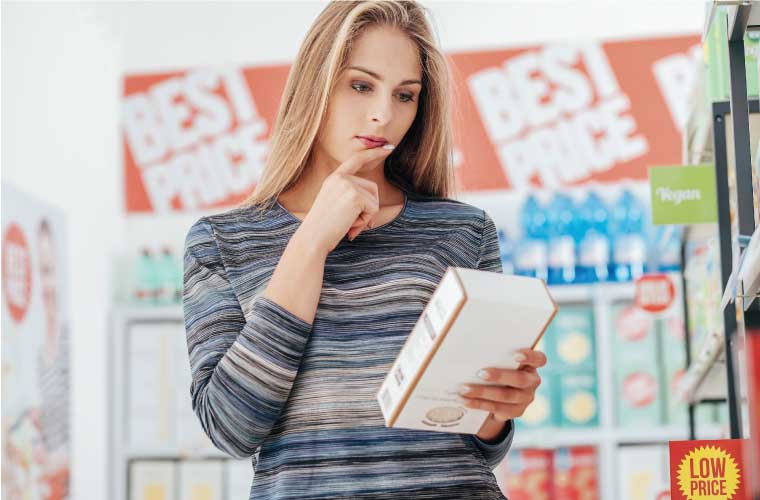With the countless brands of baby food available in the supermarket nowadays, it’s only natural that manufacturers go the extra mile to make sure that their products stand out on the shelves, hence all those attractive illustrations, colours, and designs on baby food packagings. However, it’s the label on a baby food product that tells all. In fact, they tell so much that it might sometimes get confusing. Here’s how to read food labels and work out how healthy (or not) a baby food product is.
What’s on a food label
Food labels are undervalued and underestimated on many food products, despite being present on almost every kind of food we buy. With the exception of fresh foods, such as fruit and vegetables and local baked goods, almost every kind of food we buy at the supermarket or grocery stores are have labels on them to let us know:
- The product name
- What’s in it
- Its special features, if any
- Any other additional information such as its country of origin, website, weight, etc.
Labels on baby food products should never be overlooked for they provide you with important information about who made the product, where it came from and the ingredients in that end product.
Nutritional information panel
This is an important part of the food label. These tell you what kind of nutrients the baby food contains and how much of each nutrient there is. Hence, they ultimately tell you if a product is nutritious or otherwise.
In regards to this fact, just because something is produced to be consumed by babies, it doesn’t necessarily mean that it’s nutritionally complete, and neither does it mean that there will not be any ingredients in it that are unsuitable for your baby. A tiny little irony here is that while labels give out information on how healthy a food is, some of the healthiest food, such as fresh fruits and vegetables or fresh meat and fish, are not labeled.
What your baby food label should include
At the back of all baby food packagings, there should be a box with a heading such as ‘Nutritional information’, where you should see categories like:
- serving size
- energy
- protein
- fat
- carbohydrates
- dietary fibre
- sodium
List of ingredients
All labels must include not only the ingredients found in the product but also the amount. For example, the label on a jar of mashed carrots may indicates: Carrots (25%); Water (20%), etc.
All ingredients must also be listed in descending order by weight, including added water. The ingredient listed first usually makes up the largest portion of the product. So if wheat is the first ingredient it means that wheat is the main ingredient, and the products contain a lot of it. The ingredient listed last is usually present in the smallest amount.
Nutritional information panels
All foods have to list the following nutrients on their nutritional information panels:
- energy (kilojoules)
- protein
- total fat
- saturated fat
- total carbohydrates
- sugars
- sodium
Other nutrients may or may not be included in the label. Comparing nutritional information on different food products helps you work out the healthiest choice. As responsible parents, you’ll want to choose baby food which is the lowest in saturated fats, sodium, and sugar.
Tip
When you’re comparing two products, look at the ‘per 100 gm’ information on each, rather than the ‘per serving’ information. This way you can compare the same thing on each product.
Unexpected ingredients that could be hiding in baby foods
As parents become increasingly concerned about the unwanted ingredients in baby food products, many manufacturers too are quite careful so as to not list components such as fat, sugar or salt plainly as so – This is unfortunate, but true. Instead, these ingredients may be disguised by different names and end up ‘hidden’ on the nutritional information panel or ingredient list.
Some names fat go by, for instance, are: butter, shortening, coconut, palm oil, copha, cream, dripping, lard, mayonnaise, sour cream, vegetable oils, hydrogenated oils, full cream milk powder, mono/di/triglycerides, etc.
Sugar might be called lactose, maltose, monosaccharides, brown sugar, corn syrup, dextrose, disaccharides, fructose, glucose, golden syrup, honey, fruit juice concentrate, fruit syrup, malt, mannitol, maple syrup, molasses, raw sugar, etc.
Salt might be listed as onion salt, MSG, rock salt, sea salt, baking powder, booster, celery salt, garlic salt, sodium, yeast extract, sodium bicarbonate, sodium metabisulphite, sodium nitrate, nitrate, etc.
Pay attention to this!
A baby food product may state a food allergy warning, so do take heed. So far, there are eight foods identified to be responsible for 95% of all severe allergic reactions, especially in babies, and they are:
- seafood
- fish
- milk
- eggs
- soybean
- wheat-based grains
If these ingredients are in a baby food product, it should be stated so on the label, no matter how small the amount. However, the information can be stated in a few different ways, so parents will have to know what they’re looking for when it comes to food allergens. For example, if you’re checking a product for eggs, you’ll have to look out for the following as well:
- albumin (egg)
- egg albumin
- at the end of the ingredients list – ‘contains egg’
Manufacturers might include a ‘May contain traces of’ warning if the product was manufactured using the same equipment as, or manufactured close to other foods that contain potential food allergens. These statements however are voluntarily included by manufacturers, so a product that doesn’t include such statements might not necessarily be safer than the ones that do.
















